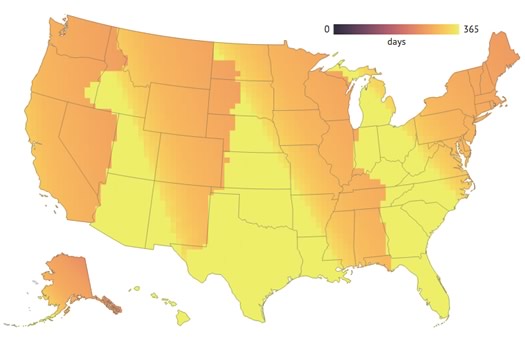When the sun goes down

The number of days places have with sunsets after 5 pm under the current standard time/daylight savings time arrangement. / map: Andy Woodruff
Check out this map: It depicts how many days out of the year with sunsets after 5 pm in each place around the United States. It was created by cartographer Andy Woodruff as part of a look at how standard time and daylight savings time affects sunrise and sunset times around the country. Woodruff built interactive maps to depict differences if the country just stayed on standard time all the time -- or went with daylight savings time all the time. (It'll make sense when you see it.) Head on over and click about. [via CityLab]
We're coming up on the shortest daylight day of the year -- it's December 21, the winter solstice (as you know). But if you're anything like us, it's the early sunsets that are kind of gloom inducing. And the earliest sunsets of the year are just about a week away -- December 7-10 -- 4:21 pm.
To illustrate the how the length of sunlight expands and contracts through out the year here, we pulled together a few graphs. Have a look -- they're after the jump.
Graphs are above in large format -- click or scroll all the way up.
Hi there. Comments have been closed for this item. Still have something to say? Contact us.


Comments
The map really points out how, if it were really all about maximizing daylight, the timezones should be set on NW to SE lines rather than pure North/South lines.
And what about all those odd counties in Indiana? :)
... said komradebob on Nov 30, 2015 at 4:16 PM | link
I have always considered December 21st the beginning of winter's death rather than it's birth.
... said Barold on Dec 1, 2015 at 8:51 AM | link
This is fun and reminds me of something I saw this summer.
There was an interesting study that came out that looked at the impact of sunset timing and wages (Gibson and Shrader). They compared cities that were on two opposite sides of a time zone line. So in these spots sunrise would be at 7 am for some and 6am for others. The people who live on a eastern edge of a time zone (Portland), get more sleep, get to work earlier, and are more productive. Those on the western edge (Ann Arbor) of a time zone are battling circadian rhythms, get less sleep, and are less productive. The authors estimate that people on the eastern edge will earn 4.5% in wages over their lifetime than people on the western edge.
A freakonomics podcast did a nice summary of the paper and other economics of sleep issues.
... said Laura on Dec 1, 2015 at 10:00 AM | link